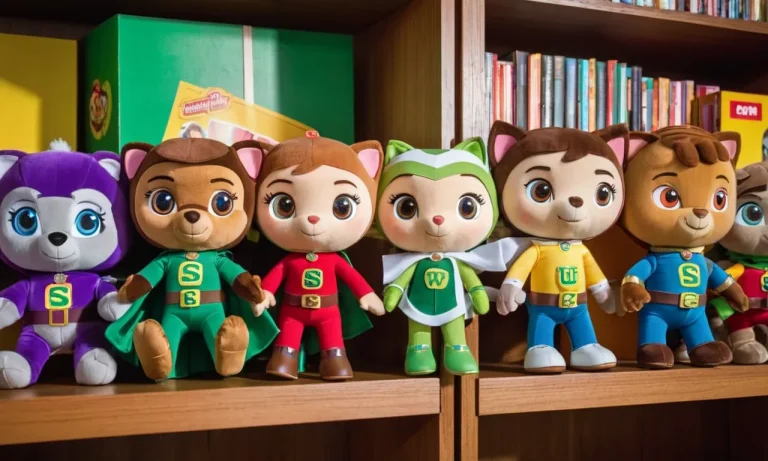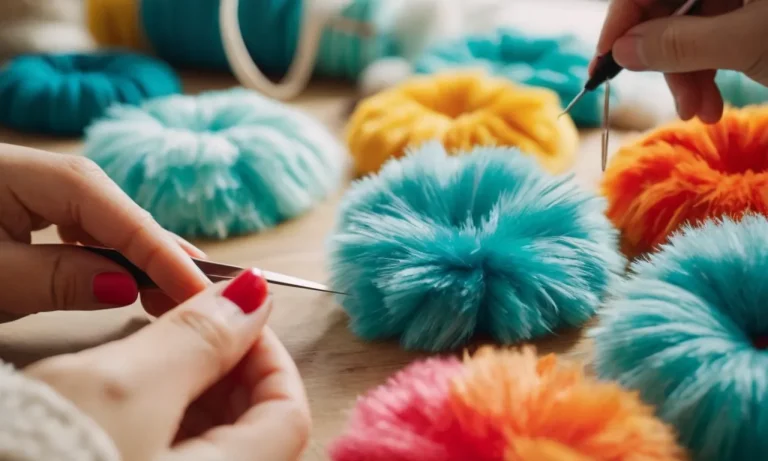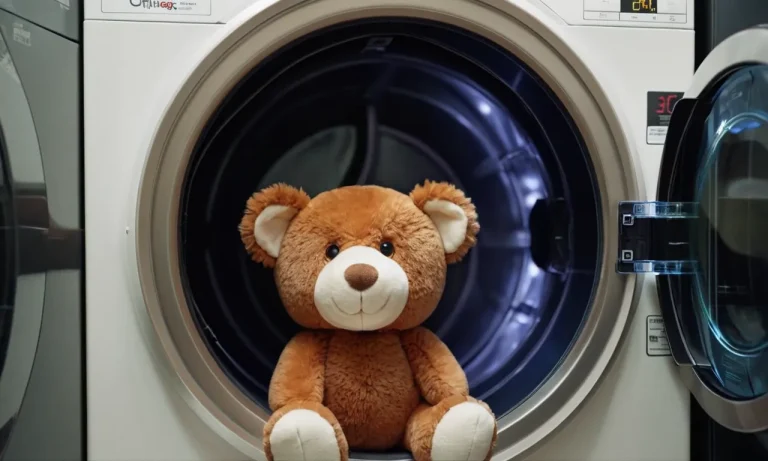Have you ever wondered what that cuddly stuffed animal is made of as you drift off to sleep? Stuffed animals have brought comfort and joy to children and adults for generations. But with so many different types of fabrics, fillers, and manufacturing processes used today, their ingredients may not be as simple as the cotton or wood shavings stuffed into toys of old.
If you’re short on time, here’s a quick answer: Most modern stuffed animals use synthetic fabrics like polyester or acrylic plush for the outer material, with stuffing made from polyester fiberfill stuffing or plastic pellets known as bean bag beads.
In this comprehensive guide, we’ll explore the most common materials used to create stuffed animals sold today. We’ll look at the outer fabrics or “skins,” the inner fillers, safety considerations, and manufacturing processes.
We’ll also take a peek at some innovative new materials entering the market.
Plush Outer Fabrics
Polyester Plush
Polyester is one of the most common fabrics used for stuffed animal plush. It is a synthetic material made from petroleum that can be produced cheaply while still feeling soft to the touch. Polyester plush has good durability and maintains its color well through repeated washings.
According to the NPD Group, polyester accounts for 22% of materials used in stuffed toys sold in the US as of 2018.
Acrylic Plush
Like polyester, acrylic is a synthetic fabric made from petroleum. It has a soft, wooly texture that works well for stuffed animals. Acrylic plush is very durable and resistant to chemicals, heat, and sunlight. It provides vibrant colors that hold up well to cleaning and repeated use.
The downside is that acrylic does not breathe as well as natural fibers. High quality acrylic may be found in collectible stuffed animals from companies like Build-A-Bear Workshop.
Cotton Plush
For a soft, natural feel many stuffed animals use plush made from 100% cotton. Cotton offers breathability and comfort, conforming to a child’s body as they cuddle their stuffed friend. Cotton plushies can be safely machine washed and dried.
The main drawback is that natural cotton is not as colorfast as synthetics, tending to fade over time. Using higher quality threads can help cotton plush better retain its hue. Brands like Jellycat lean on the comfort of cotton plush for their stuffed animals.
Microfibers
Some modern stuffed animals utilize high-tech microfiber fabrics. At less than one denier thick, microfiber plush consists of extremely fine synthetic threads that feel unbelievably soft and smooth. Microfibers provide vivid colors, a supple texture, and reliable durability.
They allow for delicate, high precision elements in stuffed animal design. The tiny fibers resist stains, dirt, and wrinkles. Major brands adopting microfibers include Ty and Aurora.
| Fabric | Pros | Cons |
|---|---|---|
| Polyester | Durable, affordable, colorfast | Not breathable, synthetic |
| Acrylic | Soft, weather resistant, vivid colors | Not breathable, petroleum based |
| Cotton | Breathable, conforms to body | Prone to fading |
| Microfiber | Extremely soft, precision design | Synthetic, not biodegradable |
With the variety of plush fabrics available, stuffed animal manufacturers can choose materials that balance quality, cost, and safety factors. Decisions depend on the animal’s size, target age range, anticipated handling, and desired softness. Combining fabrics helps to leverage their strengths.
The result is an endless array of delightfully squeezable stuffed friends to comfort and inspire growing minds.
Inner Stuffing Materials
Polyester Fiberfill
Polyester fiberfill is one of the most common stuffing materials used in stuffed animals and plush toys. It is a synthetic fiber made from petroleum-based chemicals. Polyester fiberfill is soft, lightweight, and designed to retain its shape well with long term use.
It provides a good amount of firmness to give plush toys a full, squeezable feel.
Some key advantages of polyester fiberfill include:
- Affordable price
- Hypoallergenic properties
- Retains shape and resists clumping
- Easy to wash and dries quickly
Major stuffed animal brands like Ty, Build-A-Bear, and Jellycat often use high quality polyester stuffing in their plush toys.
Plastic Pellets
Some less expensive stuffed animals are filled with plastic pellets instead of polyester fiberfill. These small hard plastic pieces provide structure at lower material costs. However, plastic bead stuffing does not offer the same soft squeezable feel as high quality plush toys.
While cheaper, plastic pellets have some disadvantages in stuffed animals:
- Makes a crinkling noise when squeezed
- Can feel lumpy rather than uniformly stuffed
- Does not retain shape as well long-term
- Durability issues as beads degrade over time
Using plastic pellets also raises some environmental concerns due to the use of non-biodegradable petroleum-based materials. Several brands offer eco-friendly plush toys with alternative stuffing materials as more sustainable options.
Organic Materials
Some newer plush toys are stuffed with natural, biodegradable materials from renewable sources. Using organic components allows brands to market stuffed animals as completely eco-friendly and sustainable.
Common organic stuffing ingredients include:
- Kapok fibers from seed pods
- Wool from sustainably raised sheep
- Cotton from organic certified farms
- Buckwheat hulls leftover from food production
- Shredded rubber from recycled tires
While more environmentally-conscious, these natural fillers can be pricier than synthetic options. Organic materials also have some performance drawbacks like clumping issues or inviting pests without chemical treatments.
But for consumers prioritizing sustainability, eco-stuffed plush presents an exciting, compassionate choice for kids and collectors alike. 👍
Innovative Fillers
Some companies also offer innovative stuffing materials that provide unique benefits beyond basic filling needs in plush toys. These can include:
| Filler | Description | Key Benefit |
| Scented beads | Plastic beads infused with fragrance oils | Provides pleasing aromas |
| Phase change materials | Encapsulated waxes, salts or gels | Provides heat/cooling sensations |
| Weighted beads | Glass beads in poly pellets | Provides calming feel from light pressure |
These specialty filler ingredients allow plush toy makers to create sensory experiences beyond just tactile softness and sqeezability. While often more expensive, for some consumers these extra characteristics are worth the added cost.
As textile technologies advance, we can expect continued new innovations that give common stuffed animals exciting modern features and benefits. The beloved plush toy category seems destined to get even more awesome and huggable over time! 🤗
Safety Considerations
Chemicals
Some stuffed animals may contain harmful chemicals like flame retardants, which can be toxic. These help meet flammability standards but could be concerning, especially for young children who put toys in their mouths.
When possible, choose certified non-toxic toys made from natural, organic materials.
Allergens
Stuffed animals often contain common allergens like wool, latex, cotton, polyester fillings, dyes, glues and more. Those with asthma or environmental allergies should take caution and check labels carefully.
Consider hypoallergenic varieties made of materials like high-quality polyester or microfiber stuffing.
Choking Hazards
Loose parts on stuffed animals pose choking risks for kids under 3. Check labels for age recommendations. For young ones, avoid toys with buttons, bows, ribbons, or small, detachable accessories that could detach and block airways. Supervise play and check for damage often.
Consider sizes – large stuffed animals are safest for little hands and mouths.
While most stuffed animals meet safety standards, being an informed consumer on risks like chemicals, allergens and choking hazards can help you find the safest options for your family.
Manufacturing Processes
Cutting
The first step in stuffed animal manufacturing is cutting out the fabric pieces that will be sewn together. Many factories now use computer-guided machines called die cutters that precisely slice through layers of fabric, cutting complicated pattern pieces with ease.
This automated process is incredibly quick and accurate, maximizing fabric usage by tightly packing pattern pieces and enabling complex shapes.Studies show die cutters boost efficiency by 25% over manual fabric cutting.
Sewing
After cutting comes my favorite part – sewing! Skilled sewing machine operators expertly stitch together the piles of fabric pieces, transforming them into recognizable stuffed animals right before your eyes.
High-tech computerized sewing machines cruise along at up to 2,500 stitches per minute, crafting perfect seams while operators monitor production. Without the speed and precision of modern sewing technology, your cute plush pal would still be a heap of fabric.
Filling
Now we’ve got our basic stuffed animal shape – time for the good stuff inside! Most modern plush pals are filled with a super soft polyester fiber called polyfil. Fluffy polyfil stuffing conforms to a stuffed animal’s body, creating irresistible squishiness begging to be squeezed.
Technicians weigh out exact amounts of stuffing for each animal size to guarantee ideal softness from head to toe. Under-stuffed or lumpy animals won’t delight their new owners!
Finishing
The final manufacturing step is finishing – adding those finishing touches to bring our plush buddies to life. Adorable eyes, noses, mouths and other accessories like bows or hats are carefully hand-stitched or securely glued in place by skilled workers.
Safety is paramount, so each accessory attachment undergoes meticulous inspection. The finishing experts know just how to make stuffed cuties cute as can be and safe for playtime cuddles!
Conclusion
We’ve explored the most common fabrics, stuffing materials and manufacturing techniques used to produce the beloved stuffed animals found in homes across the globe today. While ingredients have evolved from the early days, the magical feeling of having a special plush companion endures.
Knowing what’s inside your stuffed friend isn’t meant to take away the whimsical enjoyment for kids and kids-at-heart. But having a discerning eye can help make educated purchases and ensure safe, long-lasting quality.







